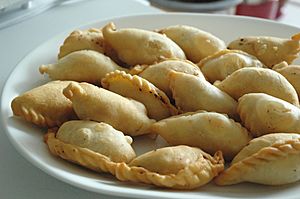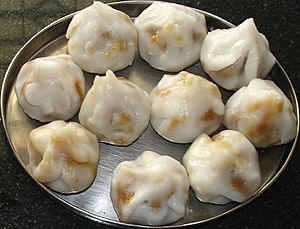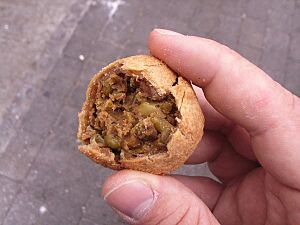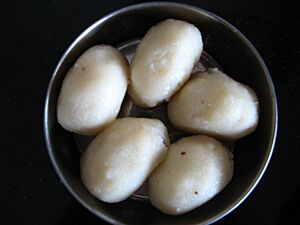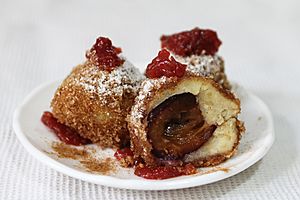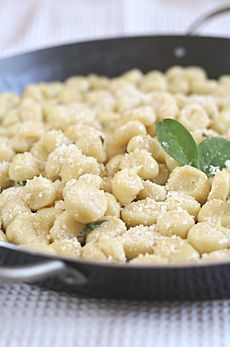Dumpling facts for kids
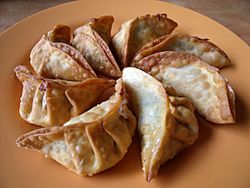
Singapore fried dumplings
|
|
| Main ingredients | Flour, potatoes or bread |
|---|---|

Dumplings are a super diverse type of food found in many different cuisines around the world. They can be sweet or savory! A dumpling is usually a small piece of food wrapped in dough, pastry, or even leaves. Sometimes, they are just balls of dough cooked on their own.
Contents
Dumplings Around the World
Dumplings are enjoyed in countless ways across the globe. Let's explore some of the most interesting types from different continents.
African Dumplings
Many African dishes fit the idea of a dumpling. They are often starchy balls of dough that are steamed or boiled.
West African Dumplings
- Banku and Kenkey are popular in West Africa. They are made from fermented cornmeal. Banku is boiled and needs lots of mixing, while Kenkey is partly boiled and then steamed in corn or banana leaves.
- Fufu is another common dish, especially in Ghana and Nigeria. It's made by pounding boiled cassava or yam until it's a thick, doughy ball. Sometimes, plantain or cocoyam is added. While not a true dumpling, some versions made from steamed flour are very similar.
East and South African Dumplings
- Tihlo comes from the Tigray region of Ethiopia. It's made from roasted barley flour and is now popular in other parts of Ethiopia too.
- Souskluitjies are sweet dumplings from South Africa. They are steamed and can have dried fruits or other flavors. People often serve them with cinnamon syrup or custard sauce.
- Melkkos is another South African dumpling. Small dumplings are formed by adding milk to dry flour, then boiled in milk and butter. They are served hot with cinnamon sugar.
American Dumplings
American dumplings are often soft and fluffy, cooked in soups or baked with fruit.
Savory American Dumplings
- American dumplings can be made with eggs, milk, baking powder, or just flour and water. Some are rolled thin and cut into pieces, while others are dropped as small balls into boiling liquid.
- Chicken and dumplings is a popular comfort food, especially in the Midwestern and Southern U.S. Small pieces of dough are cooked in chicken broth with vegetables, making a thick soup or stew.
- Tortilla dumplings are made by adding tortillas and fillings to boiling broth. You can find many kinds of savory dumplings in the South, like chicken, turkey, ham, and even butter-bean dumplings.
Sweet American Dumplings
- Baked dumplings are also very popular. These sweet treats are made by wrapping fruit, often a whole apple, in pastry. They are then baked until golden and soft. Sometimes, they are baked in a sweet sauce, like caramel or cinnamon.
Asian Dumplings
Asia has a huge variety of steamed dumplings, many with long histories and special traditions.
Central Asian Dumplings
- Manti (or manty, mantu) are steamed dumplings popular across Central Asia, including Afghanistan, Kazakhstan, and Uzbekistan. They are usually filled with ground lamb or beef, spiced with black pepper, and wrapped in dough. Manti are cooked in special steamers and served with butter, yogurt, or sour cream.
- Chuchvara are tiny boiled dumplings from Uzbek and Tajik cuisine. They are like small versions of Russian pelmeni or Chinese wontons, filled with meat (but no pork, following Islamic rules). They can be served in soup or with vinegar and sauces.
Chinese Dumplings
Dumplings have a long history in China, possibly dating back to 225 AD!
- Jiaozi are very common Chinese dumplings. They usually have minced meat (like pork, beef, or chicken) and chopped vegetables wrapped in dough. Fillings vary, but pork with Chinese cabbage or garlic chives are popular. Jiaozi are often boiled, steamed, or fried. They are a traditional dish eaten on Chinese New Year's Eve and for family reunions. In Northern China, eating jiaozi on the Winter Solstice means a warm winter.
- Guotie (or "potstickers") are jiaozi that are first steamed with a little water in a pan, then fried until the bottom is crispy and brown.
- Wonton (雲呑/餛飩) is another type of Chinese dumpling. They are usually boiled in a light soup and have a meatier filling. Wonton wrappers are thinner and less stretchy than jiaozi wrappers. Wontons are more popular in Southern China, while jiaozi are preferred in the North.
- Zongzi (粽子) are unique dumplings made with glutinous rice. They are often triangle or cone-shaped and can be filled with red bean paste, Chinese dates, or cured meat. Zongzi are traditionally eaten during the Duanwu Festival.
- Xiaolongbao (小籠包/小笼包) are famous "soup dumplings" that have a delicious broth inside.
- Tangyuan are sweet Chinese dumplings made from glutinous rice flour. They are filled with sweet sesame, peanut, or red bean paste, or sometimes served plain. Tangyuan are eaten on the 15th day of Chinese New Year.
- You can find many other kinds of dumplings in dim sum, like har gow (shrimp dumplings) and siew mai.
Indian Dumplings
Indian cuisine has many dishes that can be called dumplings:
- Ada (Malayalam) is a sweet South Indian dish from Kerala. It's made with coconut and sugar wrapped in rice dough and steamed.
- Gujhia (Hindi) is a sweet dumpling made with wheat flour, filled with a milk-based sweet called khoya.
- Kachori (Hindi) is a round, flattened dumpling filled with a baked mixture of lentils and spices.
- Karanji (Marathi) or Kajjikayi (Kannada) are fried sweet dumplings filled with dry or moist coconut.
- Kozhakkattai (Tamil) is a South Indian dish with a steamed sticky rice dough shell. It can be sweet (with coconut and jaggery) or savory (with lentils and spices).
- Modak (Marathi) is another popular dumpling in Western and South India. It has a fresh coconut and jaggery filling inside a steamed rice dough covering.
- Pitha (Bihari, Oriya, Bengali, Assamese) are stuffed savory dumplings, either steamed or deep-fried.
- Samosa is a very popular fried dumpling snack in India. It's usually filled with minced meat, vegetables (like potatoes), and spices. Vegetarian samosas are also common.
- Momos are popular in Nepal and parts of India like Darjeeling and Sikkim. They are similar to Chinese jiaozi and come from the Tibetan version.
Indonesian Dumplings
Chinese immigrants brought dumplings to Indonesia.
- Pangsit (wonton) can be boiled, fried, or steamed. It's often added to chicken noodle soup.
- Siomay is an Indonesian fish dumpling served with peanut sauce.
Filipino Dumplings
- Siomai in the Philippines is similar to Chinese shumai. It's made from ground pork, beef, or shrimp mixed with vegetables, wrapped in wonton wrappers, and then steamed or fried. It's usually dipped in soy sauce with calamansi juice.
Japanese Dumplings
- Dango (団子) are sweet dumplings made from rice flour, similar to mochi. They are often served on a skewer.
- Gyōza (ギョーザ/餃子) are the Japanese version of Chinese jiaozi.
- Nikuman (肉まん) are the Japanese version of Chinese baozi (steamed buns).
Korean Dumplings
- Korean dumplings are called mandu (만두). They are typically filled with ground pork, kimchi, vegetables, and noodles, but there are many variations. Mandu can be steamed, fried, or boiled, and are also used in a soup called mandu-guk.
Mongolian Dumplings
- Buuz (Бууз) are the Mongolian version of baozi (steamed buns).
- Khuushuur (хуушууp) are fried dumplings.
- Bansh are the Mongolian version of jiaozi.
Nepalese Dumplings
- Momos (or momo-cha) are very popular steamed dumplings in Nepal. They are similar to Chinese jiaozi or Central Asian manti. They were brought to Nepal by traders from Kathmandu who traded with Tibet. Momos can be fried or steamed and are usually served with a spicy dipping sauce. Momo soup and pan-fried momos (kothey momo) are also popular.
- Yomari (or Yamari) is a special dumpling of the Newar community in Nepal. It's a steamed dumpling with a rice flour covering and a sweet filling like chaku (a sweet molasses-like substance). Yomari is an important part of the Yomari punhi festival.
Caribbean and Latin American Dumplings
This region features many fried or baked dough pockets with savory fillings.
Empanadas
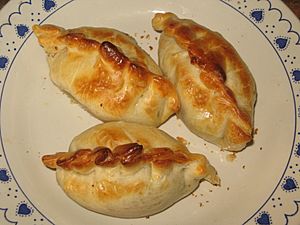
- Empanadas are popular throughout Latin America. They are dough pockets with many different fillings, which are usually deep-fried or baked.
Specific Regional Dumplings
- In Barbados, dumplings are slightly sweet and flavored with cinnamon and nutmeg. They are often added to Bajan soup or steamed with stews.
- In Brazil, you'll find pastéis, coxinhas, and bolinhas de carne. These are fried dumplings filled with chicken, pork, or beef mixed with spices. People often eat them on the beach.
- In Chile, pantrucas are flat, irregular dumplings flavored with parsley and served in soup.
- Jamaica has three kinds of dumplings: fried, boiled, and roasted. They are made with flour, sometimes mixed with cornmeal. They are often served with breakfast dishes like ackee and saltfish. A "Johnny Cake" is a purely fried white flour dumpling.
- In Peru, Papas Rellenas are stuffed potatoes. Mashed potatoes are flattened, filled with sautéed meat (beef, pork, or chicken), onions, and spices, then rolled in flour and deep-fried.
- In Puerto Rico, dumplings are made from grated root vegetables like yuca and malanga, mixed with squash, unripe bananas, and flour. They are used in pigeon pea soup.
- Another Puerto Rican dumpling is the pasteles. It's made from grated root vegetables, squash, plantains, and unripe bananas, filled with stewed pork, chickpeas, olives, and raisins. They are wrapped in banana leaves and boiled.
European Dumplings
Europe has a wide range of dumplings, from savory additions to stews to sweet fruit-filled desserts.
British and Irish Dumplings
- Savory dumplings are a traditional part of British and Irish cuisine. They are usually made from flour and suet (a type of fat), mixed with cold water, salt, and pepper. Balls of this dough are dropped into bubbling stew or soup and cooked until they are airy inside and moist outside. Herbs or cheese can be added for flavor.
- Sweetened dumplings with dried fruit and spices can be boiled for dessert. In Scotland, this is called a clootie dumpling, named after the cloth it's cooked in.
Central European Dumplings
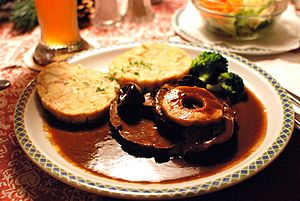
Germany, Romania, Austria, the Czech Republic, and Slovakia have many sweet and savory dumplings.
- In Northern Germany, a dumpling is called Kloß. In Southern Germany and Austria, it's Knödel, Nockerl, or Knöpfle. These are often flour dumplings made with eggs and semolina, boiled in water.
- Liver dumplings are often added to soup. Thüringer Klöße are made from raw or boiled potatoes and sometimes filled with croutons.
- Bread dumplings are made with white bread and can be boiled in a napkin, becoming "napkin dumplings" (Serviettenknödel).
- Maultaschen are a specialty from Swabia, Germany. They are like large ravioli, filled with sausage meat, spinach, bread crumbs, and onions.
- Halušky are small dumplings popular in Central and Eastern Europe. They are made from a thick flour and egg batter, similar to German Spätzle.
- In Romania, dumplings with plums inside are called galusca cu prune. In Hungary, sweet varieties called gombóc are made with potato dough wrapped around whole plums or apricots, then boiled and rolled in bread crumbs.
- Bryndzové halušky is the national dish of Slovakia. It features small potato dumplings without a filling, served with salty sheep's cheese.
- In the Czech Republic, knedlík can be bread or potato-based. These loaf-shaped dumplings are boiled and sliced, served with many Czech dishes. Ovocné knedlíky are ball-shaped dumplings filled with fruit like plums or strawberries, served with cheese, melted butter, and sugar.
- Idrijski žlikrofi are Slovenian dumplings from Idrija. They have a potato filling and a unique hat shape. They are a protected traditional dish.
- Khinkali are Georgian dumplings, usually filled with spiced meat, herbs, onions, and garlic. Mushrooms, potatoes, or cheese can also be used. People often suck out the juicy broth before eating the dumpling.
Eastern European Dumplings

- Pierogi from Poland, varenyky from Ukraine, and pelmeni from Russia and Belarus are crescent-shaped dumplings. Varenyky are usually boiled or steamed, while pierogi are often fried after boiling.
- "Little ears" (uszka in Poland, ushki in Russia) are small, ring-shaped dumplings filled with meat or mushrooms. They are traditionally served in borscht or clear soup.
- Kluski are another type of Polish dumpling.

- Lithuanian dough dumplings are called koldūnai and virtiniai, usually filled with meat or curd cheese. Cepelinai are large potato dumplings filled with meat or curd, served with sour cream.
- Russian pelmeni are smaller than varenyky and only filled with minced meat, onions, and spices. The dough is very thin, and the filling is usually raw. They are boiled in water or broth and often served with sour cream. Pelmeni are believed to have originated in Siberia, where they were a good way to preserve meat during long winters.
Italian Dumplings
- Ravioli and tortellini are types of pasta that fit the definition of a dumpling. They are pockets of pasta filled with cheese, mushrooms, spinach, seafood, or meat.
- Gnocchi are another kind of Italian dumpling. The word means "lumps." They are made from a mixture of egg with potato, semolina, flour, or ricotta cheese. Gnocchi are boiled and served with melted butter, grated cheese, or other sauces.
Maltese Dumplings
- Maltese ravioli (ravjul) are pasta pockets filled with ricotta cheese.
- Pastizzi and qassatat are dough pockets filled with ricotta or mashed peas.
- In Norway, potato dumplings have many names like potetball or komle. They are made from crushed potatoes mixed with flour, sometimes filled with bacon.
- In Sweden, potato dumplings are called kroppkaka (in the south) or palt (in the north). Kroppkaka is often made with raw potato and wheat flour, while palt uses barley flour. They are usually filled with diced, smoked bacon and onion. Blodpalt is a variant made with blood mixed into the dough. Dumplings are boiled until they float and served with melted butter and lingonberry jam.
Middle Eastern Dumplings
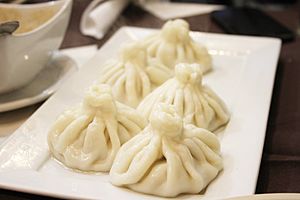

The Middle East also has its own unique dumpling traditions.
Arabic Dumplings
- Kibbeh are popular dumplings, often made with bulgur wheat and minced meat.
- Qatayef are sweet, folded pancakes often filled with cream or nuts, popular during Ramadan.
- Shishbarak are small meat-filled dumplings served in a yogurt sauce.
Caucasian Dumplings
- Armenian manti are meat-filled dumplings typically served with yogurt or sour cream. Mantapour is an Armenian beef soup with manti.
- Boraki are Armenian fried dumplings. The minced meat filling is pre-fried, and the dumplings are shaped like small cylinders with an open top, then lightly boiled and fried.
- Dushbara is an Azeri soup with tiny lamb-filled dumplings.
- Khinkali are Georgian dumplings, similar to those mentioned in Central Europe.
- Mataz are dumplings in Circassian cuisine, similar to manti, usually filled with spiced meat, greens, and onions.
Jewish Dumplings
- Kreplach are small, triangular dumplings filled with meat or cheese, often served in soup.
- Matzah ball dumplings are light, fluffy balls made from matzah meal, commonly served in chicken soup.
- Knish are baked or fried dough pockets with various fillings, like potato or meat.
Turkish Dumplings
- Manti are also very popular in Turkish cuisine, similar to the Central Asian versions.
Images for kids
See also
 In Spanish: Dumpling para niños
In Spanish: Dumpling para niños


